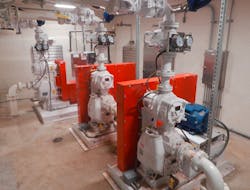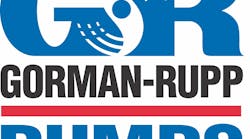Located in the southeastern corner of Pennsylvania serving a population of less than 20,000, the Newtown Township Municipal Authority’s sewer system needed three new pumping stations and rehabilitation for two existing stations.
Two and a half years into the project, four stations are up and running, with the remaining station set to be live in summer 2021. The stations are Newtown Hunt, Goshen Road, Old Masters, Camelot and Springton Pointe.
The Five Pumping Stations
There was a significant community need for the pumping stations, according to Dave Porter, project manager and project engineer for Herbert E. MacCombie, the local engineering firm tasked with designing the stations. The eastern half of the municipality’s sewerage system was in working order, but the western half needed an upgrade in order to provide reliable and efficient wastewater management.
“It was a pretty large project [considering] the eastern half of the municipality had already been sewered,” Porter said. “[In] the western half of the township, there were a lot of systems failing in a couple of neighborhoods, and we had folks that were pumping on a bi-weekly basis. So there were certain areas that were in dire need of public sewer.”
Overall, the service area would provide for approximately 961,000 gallons per day (GPD) of capacity to that half of the municipality, Porter said. In addition, 1,300 EDU’s are scheduled to come online as a result of the project, marking substantial growth opportunities for the impacted community. The pumping station project was funded by a $35 million bond issue for sewer revenue bonds sold in October 2018.
Selecting the Right Equipment
Gorman-Rupp was a vital partner to the success of the project, according to Porter. Dan Weaver, sales representative for Gayle Corp., a Gorman-Rupp distributor, assisted with the design early on in the project to help meet both the firm and authority’s goals of reliability and minimal service. The team came up with some unique solutions to better fit these needs.
“In particular, some of the unique things that were [needed for] the job [included] the head required,” Weaver said. “Very high pressure [and] very high head pumping systems were required. Fortunately for us, that fell right into some unique products that Gorman-Rupp has.”
The team designed five pumping systems, all of which use multistage pumps. Weaver’s team also recommended using bypass pumps instead of utilizing a generator, which he cited as an increasing trend. Using an engine-driven bypass pump instead of a generator allows for backup pumping when the power is out or when some part of the pump station is down. This was utilized at four of the five stations, as one station was large enough that a generator remained a viable option. To Porter, working with Gorman-Rupp on the pump design and execution brought peace of mind to the project, as their products are “the gold standard,” he said.
Developing New & Rehabilitated Pumping Stations
While three of the pumping stations were new, two were existing and rehabilitated. One of the rehabilitated sites involved essentially replacing the wastewater treatment plant, as that station has its own headworks, wet well and pumping lift station to get into the wastewater treatment plant. This involved coordinating around site development work.
The other station that required rehabilitation was a larger regional pump station that needed to be upgraded from approximately just under 400,000 GPD to just under 600,000 GPD. The station also needed to be relocated farther away from residential dwellings. In fact, working in partnership with the communities to ensure that the pumping stations met their needs was a vital part of the overall project design, Porter explained. The team even worked to coordinate the aesthetics of the buildings with the surrounding neighborhoods, with pumping station exteriors ranging from brick to fieldstone and even cedar shingles.
As mentioned, reliability was one of the key goals for all project stakeholders. For the main pump stations, Gorman-Rupp built a PLC-based panel with VFDs where each VFD had its own bypass reduced voltage starter, so if the VFD were to fault then the bypass would run. Furthermore, if the PLC were to fail, there is a backup float system that would run the pumps. If that failed, there is a backup engine-driven pump system that has its own level control system to further run. These three levels of backup support ensure station reliability.
Gorman-Rupp also tested the completed unit at the factory test pit prior to delivery. The manufacturer even invited Porter, Weaver and several other stakeholders to witness the testing of the largest station at Gorman-Rupp. Porter describes this opportunity to see the design in action as “awe-inspiring.”
“We were fascinated to be able to see hands-on how our design, calculations and our coordination with Dan [Weaver] was able to bring this to fruition,” Porter said of the Gorman-Rupp factory trip. “It was valuable to see, first-hand, the operation they have going on there.”
Beyond reliability, other elements of the overall design ensure long service life and minimal service, including the multistage bypass pumps, stainless steel impellers and stainless steel self- cleaning wearplates. A RACO alarm alert for cellular communication provides online data access and recording to ensure any issues are addressed in a timely manner.



